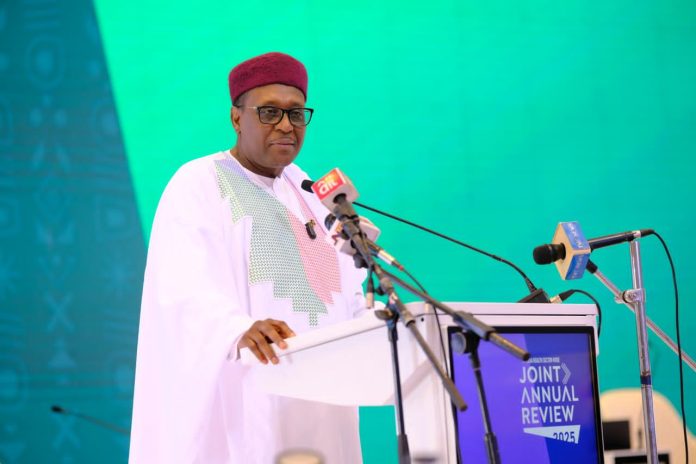By Emmanuella Oghenetega
Muhammad Ali Pate, the Coordinating Minister of Health and Social Welfare, has asserted, that confidence in the overall direction of the health system has risen to 55 percent, while confidence in government’s capacity to manage health emergencies is now at 67 percent.
Stating, that the proportion of citizens who believe that government considers their views in health decision-making now stands at nearly half the population.
He further asserted, that patient satisfaction with healthcare facilities and primary healthcare services remains strong at 74 percent. “This is a commendable result, given the challenges our system still faces.”
Speaking at the opening ceremony of the Nigeria Health Sector-Wide Joint Annual Review 2025 in abuja yesterday, which had the Theme: All Hands, One Mission — Bringing Nigeria’s Health Sector to Light, Prof. Pate stated, that skilled birth attendance coverage has increased by 33 percent, and within the priority LGAs, 4,000 free caesarean sections have been conducted in NHIA-empanelled facilities.
“This follows the decision last year to include emergency obstetric care, including caesarean sections, under the national insurance benefit, removing one of the key barriers preventing women from accessing lifesaving care.
“By 2026, population data from ongoing surveys will validate and deepen these gains, but what we are witnessing now is already proof of progress.
“Fifty-two percent of these 172 LGAs now have at least two level-two primary health care facilities, and 435 facilities have been revitalized. Over 15,000 community-based health workers have been recruited across priority states, and nearly 70,000 frontline health workers have been retrained, moving us closer to our target of 120,000 by 2027,” he said.
Also speaking at the event, the Minister of State for Health and Social Welfare, Dr Iziaq Adekunle Salako, said the increase in funding is part of the ongoing implementation of President Bola Tinubu’s Renewed Hope Agenda and the Nigerian Health Sector Renewal Investment Initiative (NHSRII), which aims to make healthcare more accessible, efficient, and sustainable.
He reaffirmed that the Federal Government is working tirelessly to raise the BHCPF allocation from one to two per cent of the CRF to close financing gaps and support states to strengthen their primary healthcare systems.
The Minister disclosed that more than a dozen new federal tertiary institutions and six cancer centres of excellence have been initiated across the country, alongside the introduction of 21 new health policies and expanded health insurance coverage.
According to him, the reforms could save Nigeria up to ₦4.8 trillion annually from preventable diseases, reverse ₦850 billion lost to medical tourism, and reduce maternal and child deaths by as much as 50 per cent by 2030.
“We are producing more health workers through our expansion strategy, improving retention, and engaging Nigerians abroad as contributors to the health system, through the Power 4 Health Initiative, we are also addressing energy poverty to ensure uninterrupted health service delivery.”
He highlighted progress under the Nigeria Digital in Health Initiative, where thousands of health facilities have been digitally connected and millions of patient encounters recorded under the National Digital Health Architecture.
Earlier, the Chairman of the Nigeria Governors’ Forum (NGF) and Governor of Kwara State, AbdulRahman AbdulRazaq, described the recent ₦32.9 billion disbursement for primary healthcare delivery as a “game changer” that has improved transparency and state-level planning.
He commended the Coordinating Minister of Health and Social Welfare, Prof Muhammad Pate, for championing a data-driven and results-oriented health reform agenda.


